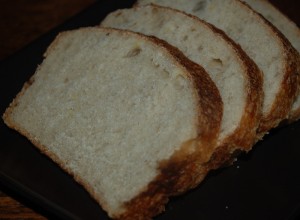Gotta Love Sourdough
 I don’t understand how anyone could not love sourdough bread. In fact, I don’t think I’ve met someone who doesn’t. It is soooo good in soooo many ways! I like mine sour-as-can-be with a rich, chewy crust.
I don’t understand how anyone could not love sourdough bread. In fact, I don’t think I’ve met someone who doesn’t. It is soooo good in soooo many ways! I like mine sour-as-can-be with a rich, chewy crust.
The flavor of sourdough bread is created by a wild yeast starter, used instead of regular baking yeast. You can purchase sourdough starter from some bakeries, or you can MAKE YOUR OWN! Making your own starter is quite a labor of love, but it makes for a very rewarding pet! It took about 5 weeks for my starter to fully develop and be ready to use for bread making, but during that time I really got to learn what the starter is all about. I even went as far as naming him Grover. I got everything I ever wanted to know about sourdough starter (and more) from: http://www.sourdoughhome.com/startingastarter.html. The best part about having your own starter is that once it is fully thriving, it can live forever as long as you feed it every once in a while. You can also give some to your friends so they can grow their own. I’ve had great success in using my extra starter in pancakes and pizza crust. Both very YUM!
This bread is great as a baguette or a sandwhich loaf- it makes two medium sized loaves. It is a good standard sourdough recipe that I got from the “Baker’s Apprentice” by Peter Reinhart. It actually isn’t as much work as it appears, but it does take some time for all that delicious wild yeast to ferment. So, make sure to read the recipe ahead of time and allow yourself a couple of days at least for the process. You can do it!
For the Starter:
- lots of organice whole wheat or rye flour
- water
To Make the Starter:
- Mix 1/2 cup water with 1/2 cup flour in a small bowl. Cover loosely with plastic wrap.
- Place the bowl somewhere relatively warm (65-85 degrees).
- Every 12 hours (about twice a day) discard 1/2 of the starter. (Until it is fully mature, you need to throw the discarded starter away. Once it is mature, you can save the discard and use it to make things like pizza dough and pancakes.) After you’ve discarded half, feed the starter another 1/2 cup water and 1/2 cup flour. Stir and cover with plastic wrap.
- Once your starter is doubling in size between feedings, it is fully mature and ready to bake with. If it doesn’t double, your bread won’t rise! This could only take one week to occur, but in my case it took several, so be patient. Also, it may double in size and fall again before you check on it, so check the sides for indication that the starter has risen.
- Once your starter is mature, you can move it to the fridge and discard/feed it once a week. When you want to bake with it again, you’ll need to take it out of the fridge a couple of days in advance and feed it every 12 hours to revive it and make enough starter as needed for your recipe.
For the Sponge:
- 2/3 cup starter
- 1 cup bread flour
- 1/8 to 1/4 cup water
To Make the Sponge:
- Remove the started from the refrigerator at least 1 hour before making the sponge.
- Mix the starter, flour, and 1/8 cup water in a small bowl with a wooden spoon, adding more water if needed to form a small ball of dough.
- Transfer the sponge to a lightly oiled bowl and cover with a damp towel.
- Allow the sponge to ferment at room temperature for 4 hours or until it has doubled in size.
- Put the covered sponge in the refrigerator overnight.
For the Bread:
- 4 1/2 cups bread flour
- 2 teaspoons salt
- 1 1/2-1 3/4 lukewarm water
- semolina flour or cornmeal for dusting
To Make the Bread:
- Remove the sponge from the refrigerator one hour before making the dough.
- Cut the sponge into 10 small pieces, set aside.
- Mix the flour and salt in the bowl of a stand mixer.
- Stir on low speed with the paddle attachment, adding the pieces of sponge and as much water as needed to form a ball.
- Mix with the dough hook on medium-low speed for 4 minutes. Adjust the water and flour as needed- the dough should be firm, but tacky.
- Transfer the dough to a lightly oiled bowl and cover with a damp towel.
- Allow the dough to ferment at room temperature for 4 hours or until it has doubled in size.
- Line a sheet pan with parchment paper and sprinkle with semolina flour or cornmeal.
- Gently remove the dough from the bowl and divide into 2 equal pieces.
- Shape the pieces into loaves and place on the sheet pan.
- Cover with loosely with plastic wrap and allow to rise for 2-3 hours or overnight in the refrigerator (if rising overnight, remove from the fridge about 4 hours before baking).
- Preheat the oven to 500 degrees.
- Place the pan in the oven and spray the loaves and the walls of the oven with water in a spray bottle.
- Spray the loaves and oven walls twice more in 30 second intervals.
- After the final spray, reduce the oven temperature to 450 degrees and bake for 10 minutes.
- Rotate the pan 180 degrees and bake for another 10-20 minutes or until the loaves are a rich golden brown color and sound hollow when tapped.
- Remove from oven and place loaves on a wire cooling rack for at least 45 minutes before gobbling up!


 I am a lover of all things sweet- baking, eating and gazing at homemade treats is one of my favorite past times!
I do have a day job (that doesn't involve baking) so my culinary adventures are pretty much limited to the weekends when I have the most time.
I have started this blog to share good recipes with friends and family and to learn from others how to make them even better.
Thanks for stopping by and doing your part to make the world a sweeter place!
-Kricket
I am a lover of all things sweet- baking, eating and gazing at homemade treats is one of my favorite past times!
I do have a day job (that doesn't involve baking) so my culinary adventures are pretty much limited to the weekends when I have the most time.
I have started this blog to share good recipes with friends and family and to learn from others how to make them even better.
Thanks for stopping by and doing your part to make the world a sweeter place!
-Kricket
July 15th, 2010 at 11:03 am
Buy:Accutane.Zovirax.Zyban.Valtrex.Retin-A.Petcam (Metacam) Oral Suspension.Mega Hoodia.Nexium.Prednisolone.Human Growth Hormone.100% Pure Okinawan Coral Calcium.Actos.Lumigan.Arimidex.Prevacid.Synthroid….